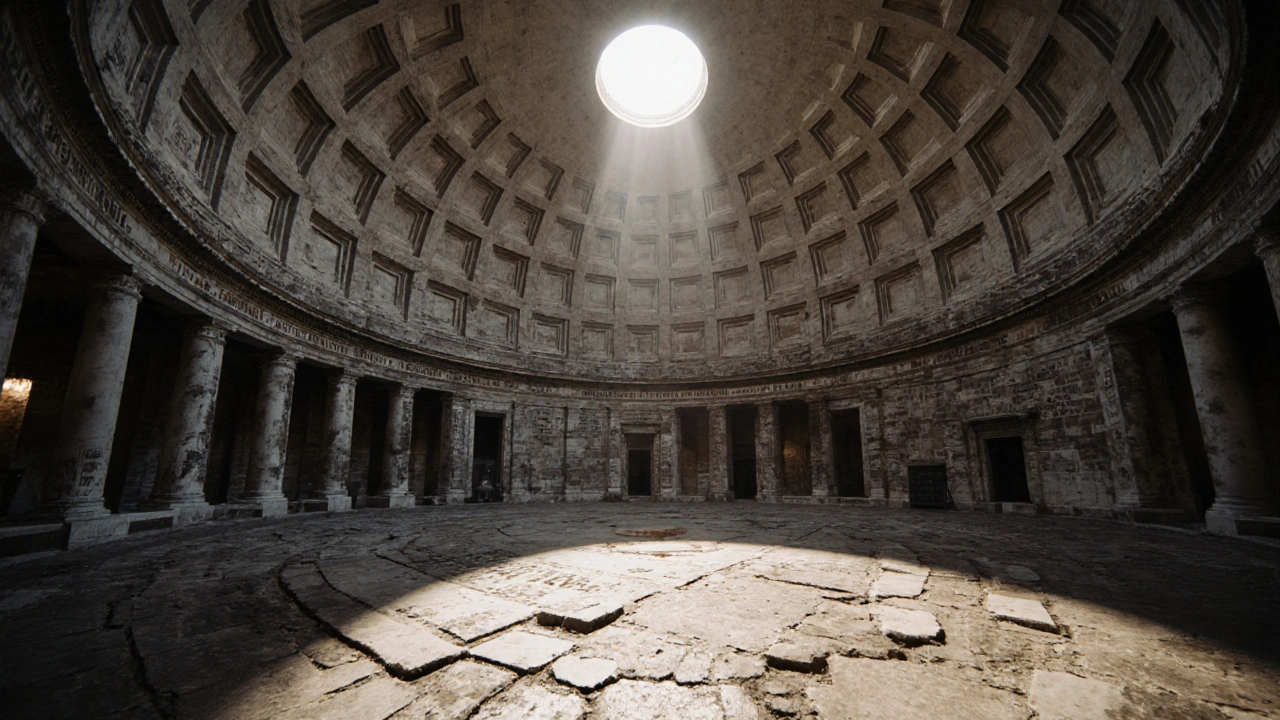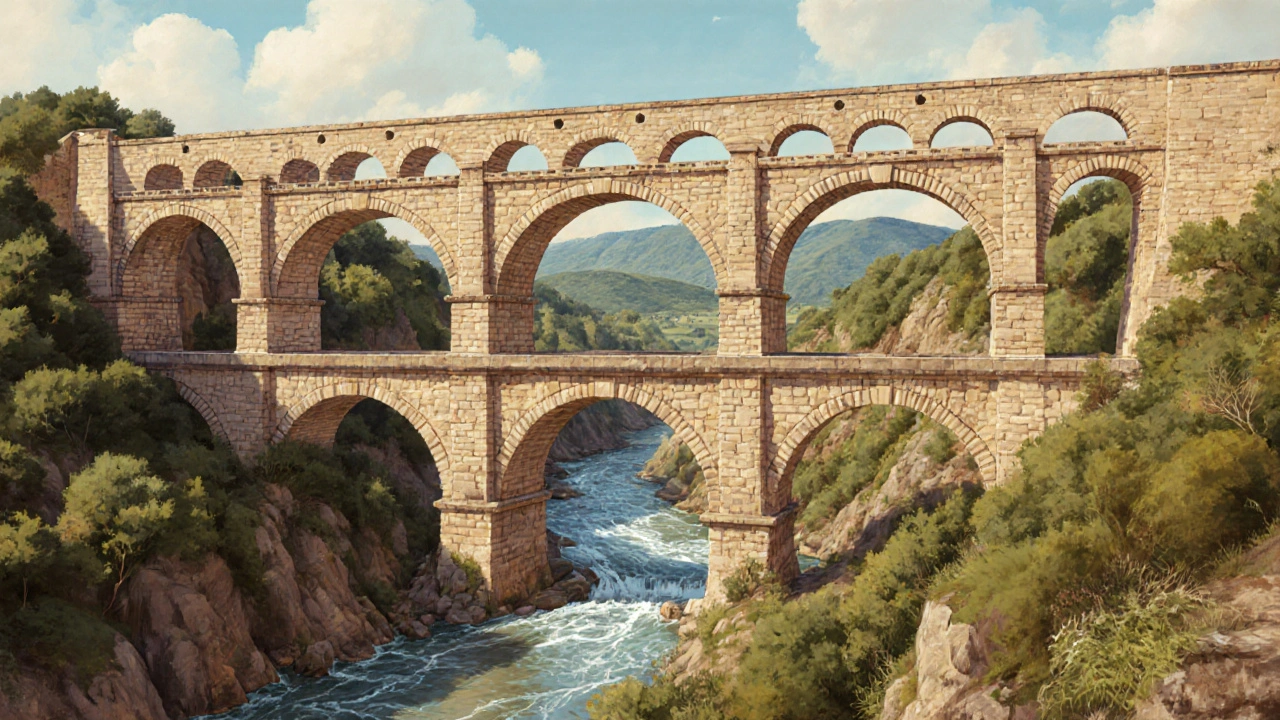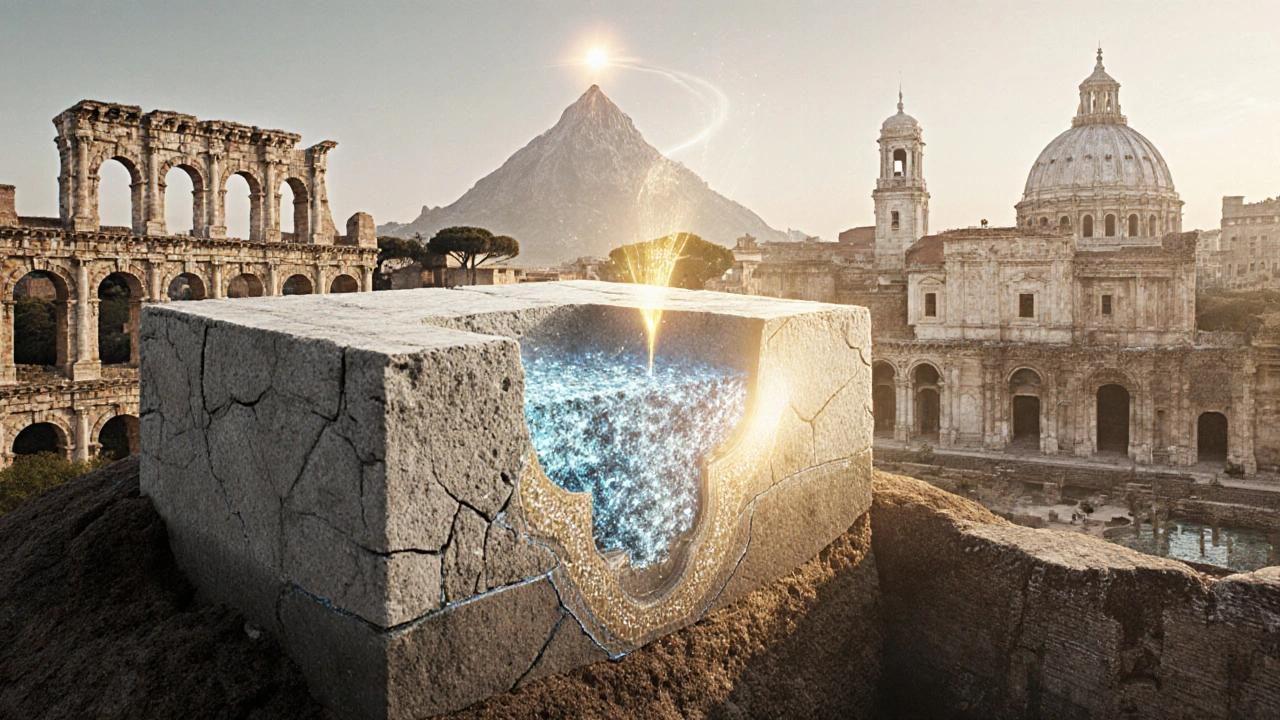Ancient Roman Architecture: How Rome Built an Empire with Stone and Concrete
 Nov, 10 2025
Nov, 10 2025
Walk through any old European city and you’ll see traces of Rome everywhere. Arches over doorways, vaulted ceilings in churches, even the shape of modern stadiums-they all trace back to one place: ancient Rome. But this wasn’t just style. It was engineering that changed how humans built for thousands of years. The Romans didn’t just copy Greek columns and temples. They reinvented construction with materials and methods no one else had, and they built things that still stand today.
The Secret Behind Roman Concrete
Most ancient buildings crumbled over time. But the Pantheon’s dome? Still standing after 1,900 years. The secret? Roman concrete. Unlike modern concrete that uses Portland cement, Roman concrete mixed volcanic ash from Mount Vesuvius with lime and seawater. This created a material that got stronger over time, especially in saltwater. Modern scientists only figured out why in 2017-turns out, the ash reacted with seawater to form new minerals that filled cracks as they formed. That’s why Roman harbors in Italy are still intact, while modern ones crumble in decades.
This wasn’t just a lucky accident. Roman engineers tested materials across their empire. They used different ash blends depending on location-pozzolana near Naples, trass in the Rhine Valley. They knew exactly what worked where. And they used it everywhere: aqueducts, bridges, baths, even sea walls. No other civilization had a concrete that lasted this long. Not the Egyptians. Not the Greeks. Just Rome.
The Arch and the Vault: Changing the Shape of Buildings
Before Rome, buildings relied on post-and-lintel systems-two vertical supports holding up a flat beam. That meant rooms were small, ceilings low, and walls thick. The Romans changed that with the arch. Not the first to use it, but the first to make it the backbone of entire structures. By stacking arches, they created vaults. By crossing two vaults, they made domes. Suddenly, they could build huge open spaces without needing dozens of wooden beams or stone pillars.
The Colosseum is the perfect example. It’s a ring of 80 arches, each one supporting the next. Inside, a system of vaulted corridors let 50,000 people move quickly and safely. No other amphitheater before or since matched its scale. And the dome of the Pantheon? Still the world’s largest unreinforced concrete dome. At 43 meters across, it’s wider than the dome of St. Peter’s Basilica in Rome. And it’s been standing since 126 AD.

Aqueducts: Engineering the Everyday
Rome wasn’t just about temples and gladiators. It was about running water. The city had 11 aqueducts, stretching over 500 kilometers total. Some carried water from mountains 90 kilometers away. They didn’t use pumps. They used gravity. A slope as gentle as 1 in 3,000 kept water flowing day and night. That’s less than a 10-centimeter drop over a kilometer.
These weren’t just pipes. They were multi-layered systems. Stone channels lined with waterproof mortar, supported by arches where the land dipped. The Pont du Gard in southern France still stands as a three-tiered bridge, carrying water across a valley. It’s not a ruin-it’s a functioning piece of infrastructure that lasted 2,000 years. Roman cities had public fountains, baths, latrines, and even indoor plumbing for the wealthy. No other ancient society came close to this level of urban water management.
The Baths: More Than Just a Place to Wash
Public baths weren’t just about cleanliness. They were social hubs. The Baths of Caracalla, built in 216 AD, could hold 1,600 bathers at once. They had hot rooms, cold rooms, exercise yards, libraries, gardens, and food stalls. The walls were lined with marble, the floors with mosaics, the ceilings with painted vaults. Heating came from a hypocaust system-hot air circulated under raised floors and behind walls, like underfloor heating in modern homes.
These weren’t luxury add-ons. They were standard in every Roman city, big or small. Even in frontier towns like Bath in England or Lutetia (Paris), you’d find a full bath complex. The Romans understood that infrastructure shaped behavior. Clean water and public space created healthier, more connected communities. It’s why cities like Pompeii had running water in 90% of homes-something most European cities wouldn’t see again until the 1800s.

Domestic Architecture: Homes for Everyone
Not everyone lived in palaces. Most Romans lived in apartment blocks called insulae. These were five to seven stories high, made of concrete and brick, with shops on the ground floor. The upper floors were rented out to families. Windows were small, lighting was poor, and fire risk was high-but they were affordable. In a city of over a million people, housing had to be dense.
Meanwhile, the wealthy lived in domus homes. These had courtyards, fountains, frescoed walls, and mosaic floors. The House of the Vettii in Pompeii still has its original paintings: gods, mythological scenes, even still lifes of fruit. The Romans decorated their homes like we decorate our living rooms today-because they cared about comfort, beauty, and status. They even had central heating, running water, and private latrines. Their homes weren’t just shelters. They were reflections of their values.
Legacy: Why Roman Architecture Still Matters
When you walk into a modern courthouse, you’re stepping into a Roman basilica. When you see a shopping mall with a glass dome, you’re seeing the Pantheon’s influence. Even the shape of your local supermarket’s entrance? That’s a Roman arch. The Romans didn’t just build structures. They built systems-water, sewage, roads, housing-that made cities work. And they did it without electricity, computers, or steel.
Modern engineers still study Roman concrete. The U.S. Army Corps of Engineers tested Roman mixtures in the 1990s to build more durable sea walls. The European Union funded research into replicating it for coastal protection. Architects today use Roman vaulting techniques to design large-span roofs without steel beams. The principles are timeless because they were built on observation, testing, and repetition-not theory alone.
Rome’s greatest gift wasn’t its emperors or its legions. It was the idea that architecture could serve the people. Not just the rich. Not just the elite. Everyone. That’s why, even now, when you see a bridge, a fountain, or a dome, you’re seeing Rome-not as a relic, but as a living blueprint.
What made Roman concrete so durable?
Roman concrete used volcanic ash, especially from Mount Vesuvius, mixed with lime and seawater. This created a chemical reaction that formed new minerals over time, sealing cracks and making the material stronger. Modern concrete, by contrast, weakens when exposed to saltwater and doesn’t self-heal.
How did the Romans build such large domes without modern tools?
They used a technique called coffering-hollowing out sections of the dome to reduce weight. They also layered different types of concrete, using lighter materials like pumice at the top and heavier stone at the base. The Pantheon’s dome is 4.5 meters thick at the bottom but only 1.5 meters thick at the top. They also built temporary wooden centering to hold the shape while the concrete set.
Did Romans invent the arch?
No. The arch existed in Mesopotamia and Egypt long before Rome. But the Romans were the first to use it systematically across entire structures-not just as decorative elements, but as load-bearing systems. They turned the arch into a building block for vaults, aqueducts, and domes, making it the foundation of their entire architectural language.
Why did Roman aqueducts last so long?
They were built with precise engineering: a steady, gentle slope ensured constant water flow without erosion. The channels were lined with waterproof opus signinum, a type of hydraulic mortar. The arches distributed weight evenly, reducing stress. And they were maintained regularly-Roman engineers had teams dedicated to cleaning and repairing them every year.
Are there any Roman buildings still in use today?
Yes. The Pantheon in Rome is still a functioning church. The Colosseum hosts concerts and events. The Pont du Gard in France is a UNESCO site and tourist attraction. In Spain, the Roman aqueduct in Segovia still carries water through parts of the city. Even modern sewer systems in Rome follow the same routes as ancient ones. These aren’t just ruins-they’re living infrastructure.
If you want to see Roman architecture in action, visit Rome, Pompeii, or even smaller towns like Verona or Trier. Walk under an arch, touch a concrete wall, or stand under a dome. You’re not just looking at history-you’re standing inside a system that still works today.